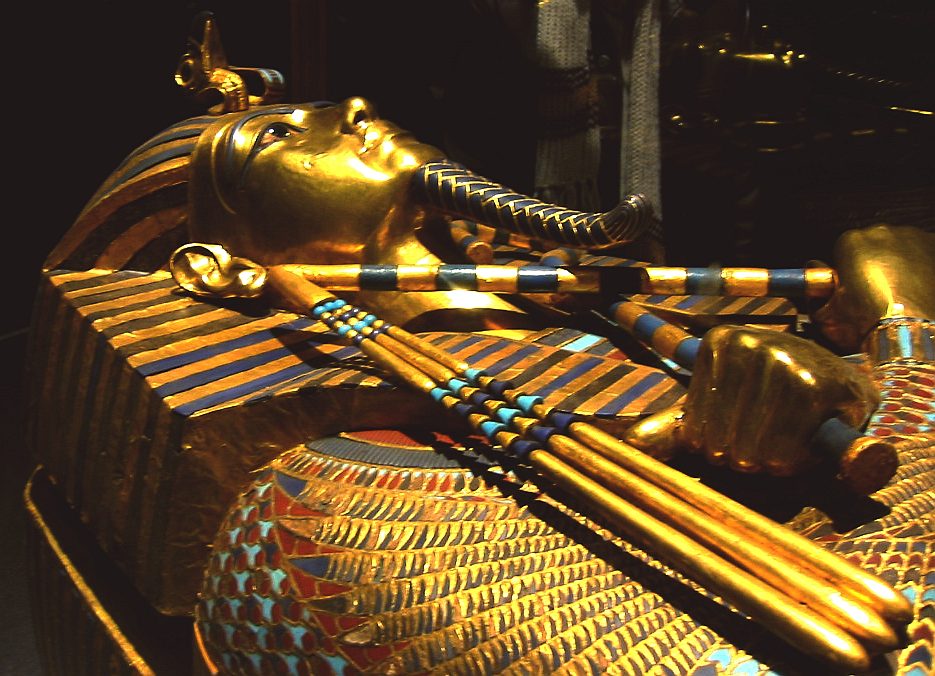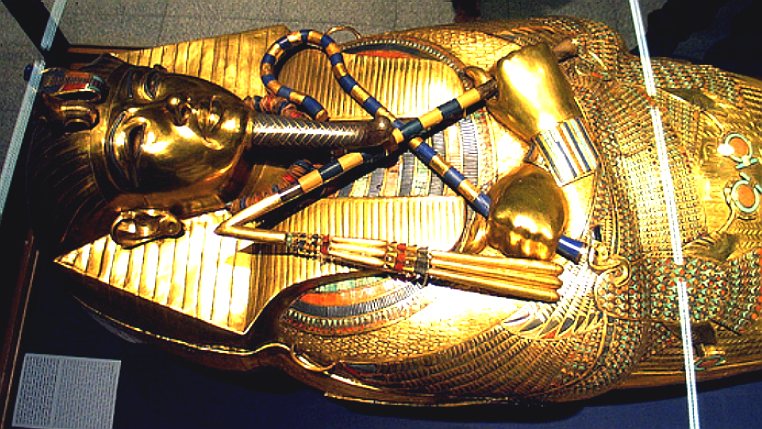Tutankhamun (alternately spelled with Tutenkh-, -amen, -amon) was an Egyptian pharaoh betwen 1341 BC – 1323 BC, of the 18th dynasty (ruled ca. 1332 BC – 1323 BC in the conventional chronology), during the period of Egyptian history known as the New Kingdom. He is popularly referred to as King Tut. His original name, Tutankhaten, means "Living Image of Aten", while Tutankhamun means "Living Image of Amun".

In hieroglyphs, the name Tutankhamun was typically written Amen-tut-ankh, because of a scribal custom that placed a divine name at the beginning of a phrase to show appropriate reverence. He is possibly also the Nibhurrereya of the Amarna letters, and likely the 18th dynasty king Rathotis who, according to Manetho, an ancient historian, had reigned for nine years — a figure which conforms with Flavius Josephus's version of Manetho's Epitome.
The 1922 discovery by Howard Carter and George Herbert, 5th Earl of Carnarvon of Tutankhamun's nearly intact tomb received worldwide press coverage. It sparked a renewed public interest in ancient Egypt, for which Tutankhamun's burial mask remains the popular symbol. Exhibits of artifacts from his tomb have toured the world. In February 2010, the results of DNA tests confirmed that he was the son of Akhenaten (mummy KV55) and his sister/wife (mummy KV35YL), whose name is unknown but whose remains are positively identified as "The Younger Lady" mummy found in KV35.
The 1922 discovery by Howard Carter and George Herbert, 5th Earl of Carnarvon of Tutankhamun's nearly intact tomb received worldwide press coverage. It sparked a renewed public interest in ancient Egypt, for which Tutankhamun's burial mask remains the popular symbol. Exhibits of artifacts from his tomb have toured the world. In February 2010, the results of DNA tests confirmed that he was the son of Akhenaten (mummy KV55) and his sister/wife (mummy KV35YL), whose name is unknown but whose remains are positively identified as "The Younger Lady" mummy found in KV35.
On February 12, 1924, English Egyptologist Howard Carter and his team removed the lid on the third and last sarcophagus of the burial chamber in tomb KV62 revealing the mummy of Tutankhamun. By February 1923, Carter had already discovered the Burial Chamber of Tutankhamun's tomb hidden in the Valley of the Kings.
Tutankhamun was the 11th pharaoh of Dynasty 18 of the New Kingdom in Ancient Egypt, making his mummy over 3,300 years old. The discovery of the tomb as a whole was one of the most significant and famous archeological discoveries in modern times. There has been great speculation about the alleged Curse of the Pharaohs and also the actual cause of death of King Tutankhamun since very little data about the young king is known.
Although most Egyptologists agree that King Tutankhamun, or King Tut (as he is commonly referred to), was the 11th pharaoh during the 18th Dynasty of the New Kingdom, what is still not exactly clear is to the exact dates of Tut's reign. An educated estimate is that he ruled over Ancient Egypt from about 1346-1355 BCE. After an initial examination of the 3,300 year old mummy, it was estimated that Tut was a teenager of approximately 17–19 years of age when he died. Since it was believed that Tutankhamun became king as child no more than 10 years old, many refer to him as the "Boy-King" or "Child-King." A majority of his reign was devoted to restoring Egyptian culture, including religious and political policies because Tut's predecessor Akhenaten (recently proven to be Tut's father) had altered many Egyptian cultural aspects during his reign, and one of Tut's many restoration policies included changing the political capital from Akhenaten's Amarna back to Memphis.
Following the discovery of Tut's mummy, much debate has arisen as to his exact cause of death. This has led to numerous medical studies and procedures performed on his remains, including as recent as 2009. As medical technology advanced throughout the years, new techniques were utilized on the mummy to discover the true age, genealogy, and cause of death of the young pharaoh (is either a war battle wound or chariot fall) so some of the mysteries surrounding the "Boy-King" could finally be put to rest.



No comments:
Post a Comment